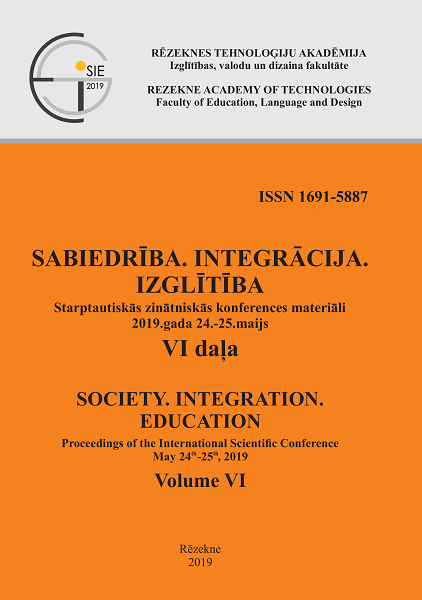RESEARCH ON THE PERSONAL INCOME TAX APPLICATION TO WAGES IN THE BALTIC STATES
DOI:
https://doi.org/10.17770/sie2019vol6.3858Keywords:
personal income tax, preference for dependent person, non-taxable minimum, tax rate, average monthly net wage, tax burdenAbstract
Personal income tax and social insurance contributions must be paid on wages into the budget, the revenue of which most directly affects the changes in the number of persons engaged in the national economy and the increase of the average wage. To be able to evaluate how favourable the personal income tax systems applicable to employees are in the Baltic States, the author compares the factors that affect taxation and the tax burden in Latvia, Lithuania and Estonia, which have experienced tax reforms in the recent years.
The aim of the research is to perform a comparative study of the requirements and issues of personal income tax application to wages in Latvia, Lithuania, and Estonia. The monographic, comparative and analytical analysis, logical construction, and grouping methods have been used in the research study. Based on the research study, the author has concluded that despite the similarities in the personal income tax systems, each Baltic state has different normative regulation. The tax burden on Estonian taxpayers relative to wages is lower than that in Lithuania and Latvia.
References
Dolenc, P., Vodopicev, M. (2005). The Tax Wedge in Slovenia: International Comparison and Policy Recommendations. Financial Theory and Practice, 29 (3), 229-243.
European Union (2018). Taxation Trends in the European Union. Retrieved from: http://ec.europa.eu/taxation_customs/resources/documents/taxation/gen_info/economic_analysis/tax_structures/2013/report.pdf
Gyventojų pajamų mokesčio įstatymas. (2002). Lietuvos Respublikos Įstatymas. Galima: https://www.e-tar.lt/portal/lt/legalAct/TAR.C677663D2202
Ķirsons, M. (12.12.2018). Ienākuma nodokļu salīdzinājums. Dienas bizness.
Laivina, S., Eglite, A. (2011). Impact of Taxes on the Budget of Latvia's Households. Economic Science for Rural Development: Resources and Education,25, 108-117.
Latvijas Nacionālais attīstības plāns 2014. – 2020. gadam (20.12.2012). Latvijas Republikas Saeimas lēmums. Pieejams: http://polsis.mk.gov.lv/documents/4247
Leinonen (2018). Taxation. Retrieved from https://leinonen.eu/group-en/services/taxation
LLU (2013). Darbaspēka nodokļu analīze lauksaimniecībā. Projekta atskaite. Pieejams: https://www.zm.gov.lv/public/ck/files/ZM/TP%20petijumi/Darbaspeka_nodoklu_analize_ls.pdf
LR Centrālā Statistikas pārvalde (2018). Darba ņēmēju skaita sadalījums pēc mēneša bruto darba ienākumiem pa sektoriem. Pieejams: https://data1.csb.gov.lv/pxweb/lv/ sociala/sociala__dsamaksa__isterm/DS200m.px/table/tableViewLayout1/?rxid=9b994c18-15d8-4425-86e2-b507c302d80a
LR Centrālā Statistikas pārvalde (2018). Strādājošo mēneša vidējā darba samaksa pa ceturkšņiem. Pieejams: https://data1.csb.gov.lv/pxweb/lv/sociala/sociala__dsamaksa__ isterm/DS030c.px/table/tableViewLayout1/?rxid=6efc26e2-1951-4f62-b6d8-e20df9610503
LR Centrālā Statistikas pārvalde (2018). Strādājošo mēneša vidējā darba samaksa pa darbības veidiem. Pieejams: http://data1.csb.gov.lv/pxweb/lv//sociala/sociala dsamaksa__ikgad/ DSG030.px/table/tableViewLayout1/?rxid=f83ae71e-e6ba-42b5-a98b-207559c5f2c9
LR Labklājības ministrija (2007). Optimāla, nodarbinātību veicinoša nodokļu un pabalstu sistēma. Pieejams: http://www.lm.gov.lv/lv/nozares-politika/darba-tirgus/darba-tirgus-statistika-un-petijumi/labklajibas-ministrijas-petijumi-13-nacionalas-programmas-petijumi
Mazure, G., Viksne, D. (2014). Income Taxation Development Trends in the Baltic States. Economic Science for Rural Development, 33, 34-44.
Neverauskiene Okuneviciute, L., Mieziene, R., Gataulinas, A. (2017). Evaluation of the Relationship between Labour Taxation and Unemployment: Case Study of Lithuania in the EU Context. Filosofija-Sociologija,28 (4), 225-235.
OECD (2013) Taxing Wages 2013. Paris: OECD.
Oficialiosios statistikos portalas (2018). Darbo užmokestis šalyje. Galima: https://osp.stat.gov.lt/naujienos?articleId=5816064
Par iedzīvotāju ienākuma nodokli (1993). Latvijas Republikas likums. Pieejams: https://likumi.lv/doc.php?id=56880
Piketty, T., Saez, E. (2012). Optimal Labor Income Taxation. NBER Working paper No. 18521, University of California.
Škapars, R., Šumilo, E., Dunska, M. (2010). Tax Politics Legal and Economic Aspects and their Impact on the Business Environment in Latvia. Riga: University of Latvia.
Snucins, I. (2012). Role and Efficiency of Personal Income Tax Reliefs in Promoting Employment nnd Social Goals in Latvia. New Challenges of Economic and Business Development, 690-740.
Statistikaametist (2018). Keskmine brutokuupalk. Saadaval: https://www.stat.ee/stat-keskmine-brutokuupalk
Szarowska, I. (2014). Personal Income Taxation in a Context of a Tax Structure. Procedia Economics and Finance, 12, 662-669. DOI: 10.1016/S2212-5671(14)00391-8
Ūksikisiku tulumaksu seadus (1991). Vabariigi seadus Eesti. Saadaval: https://www.riigiteataja.ee/akt/30512
Valsts nodokļu politikas pamatnostādnes 2018.-2021. gadam (24.05.2017.). Ministru kabineta rīkojums Nr. 245. Pieejams: https://likumi.lv/ta/id/291013-par-valsts-nodoklu-politikas-pamatnostadnem-2018-2021-gadam
Vanags, A. (2010). Tax reform in Latvia: Could it be fair? BICEPS Occasional Paper, 8.






